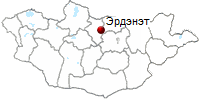 |
Orkon Aimag. Erdenet. Erdenet Mining Museum. Copper Mine.
ABOUT MONGOLIA
THE REGIONS OF MONGOLIA
ORKHON AIMAG.

- Territory - 324 square miles (840 sq. km.)
- Center - City of Erdenet, situated 255 miles (410 km.)
from Ulaanbaatar.
- Number of somons - 2
- Orkhon aimag was established in 1994.

Arich deposit of copper and molybdenum was discovered by Mongolian, Russian and Czechoslovakian geologists in the territory of the aimag in 1967-1970. In
1974, foundation of the "Erdenet" Soviet-Mongolian copper ore dressing enterprise was laid. Now the enterprise is considered as one of the ten biggest
plants in the world. Construction of the enterprise became the first step in building a new city of Erdenet. The enterprise produces 25 percent of the total
state budget, and 51.5 percent of the total national export products. Previously Orkhon aimag was a part of Bulgan aimag, therefore the
biodiversity and climate are similar to those in Bulgan.
PLACES TO VISITED.
- Erdenet. Population 74,000. In the autonomous municipality of Orkhon, and not technically part of Bulgan aimag, Erdenet is Mongolia's
third-largest city. The reason for Erdenet's existence is the copper mine, which employs about 8000 people and is the lifeblood of the city. Erdenet is
modern (built in 1974) and a bit soulless, but far nicer than most towns in the countryside. It is comparatively wealthy, so the facilities are the best
outside of Ulaanbaatar. There is also a significantly large Russian community. Up to a third of the population of Erdenet was Russian during
Communist times, though now only about 1000 Russians still work as technical advisers at the mine.
There is evidence that Mongolians were making copper pots in the Erdenet area at least 200 years ago. Russian geologists initially recognized the
area's potential during the 1940s. The copper was first seriously prospected during the 1960s, and by 1977 a train line to Ulaanbaatar was installed for
hauling the ore. In 1981 an ore-processing plant was commissioned and Erdenet began exporting copper concentrate (30% copper), mostly to the former Soviet Union.
There are rumblings about privatisation, but the cash-strapped Mongolian government isn't keen to sell off the mine, as it currently generates about
70 % of Mongolia's hard-currency earnings (depending on the current price of copper). In 1995, 208,000 tons of iron ore and 11,000 tons of molybdenum
produced at the mine generated US$ 900 million for Mongolia. The mining and processing operation consumes nearly 70 % of Mongolia's electricity.
- Friendship Monument. This Communist monument, about 200m north-east of the Selenge Hotel, is worth a quick look. On the way you pass a fine Marx
mural and a picture of Lenin bolted to the wall. A little further to the east, the ovoo is impressive if you haven't seen too many before. The hills
north of the monument and south of the stadium are great for short hikes.
- Mining Museum. This Soviet-built museum belongs to the copper-mining company, Erdenet Concern. It's on the 2nd floor of the Culture Palace, and is worth a look.
- Copper Mine. The open-cut mine (thankfully, several kilometers from the city) is one of the 10 largest copper mines in the world. You can see it
from the south of town.
Open-cut mining is more damaging to the environment but infinitely safer than digging mine shafts below the surface. Also, since this particular
mountain is almost solid copper and molybdenum ore, this is the only practical way to reach it. The mine operates 24 hours a day, 365 days a year.
The mine is worth a visit if you've never visited one like this before. The views from the lockout over the gigantic open-cut mine, and of the city, are impressive.
ADDITIONAL INFORMATION:
PAGES OF THE PICTURE ALBUM
|
|
 |
|